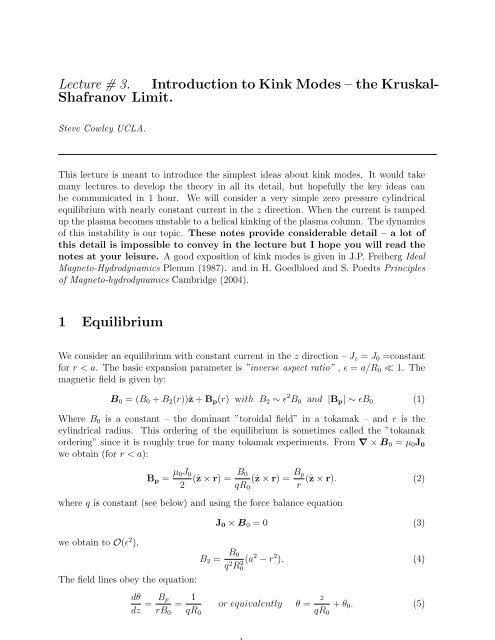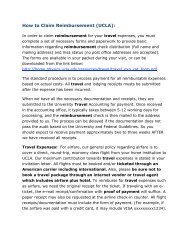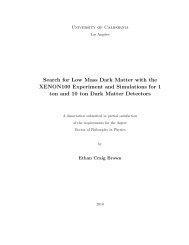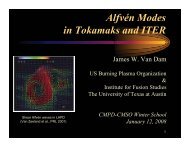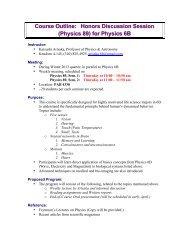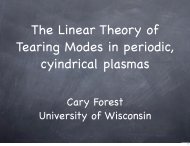Simple Linear Theory - UCLA Physics & Astronomy
Simple Linear Theory - UCLA Physics & Astronomy
Simple Linear Theory - UCLA Physics & Astronomy
You also want an ePaper? Increase the reach of your titles
YUMPU automatically turns print PDFs into web optimized ePapers that Google loves.
Lecture # 3. Introduction to Kink Modes – the Kruskal-<br />
Shafranov Limit.<br />
Steve Cowley <strong>UCLA</strong>.<br />
This lecture is meant to introduce the simplest ideas about kink modes. It would take<br />
many lectures to develop the theory in all its detail, but hopefully the key ideas can<br />
be communicated in 1 hour. We will consider a very simple zero pressure cylindrical<br />
equilibrium with nearly constant current in the z direction. When the current is ramped<br />
up the plasma becomes unstable to a helical kinking of the plasma column. The dynamics<br />
of this instability is our topic. These notes provide considerable detail – a lot of<br />
this detail is impossible to convey in the lecture but I hope you will read the<br />
notes at your leisure. A good exposition of kink modes is given in J.P. Freiberg Ideal<br />
Magneto-Hydrodynamics Plenum (1987). and in H. Goedbloed and S. Poedts Principles<br />
of Magneto-hydrodynamics Cambridge (2004).<br />
1 Equilibrium<br />
We consider an equilibrium with constant current in the z direction – J z = J 0 =constant<br />
for r < a. The basic expansion parameter is ”inverse aspect ratio” , ɛ = a/R 0 ≪ 1. The<br />
magnetic field is given by:<br />
B 0 = (B 0 + B 2 (r))ẑ + B p (r) with B 2 ∼ ɛ 2 B 0 and |B p | ∼ ɛB 0 (1)<br />
Where B 0 is a constant – the dominant ”toroidal field” in a tokamak – and r is the<br />
cylindrical radius. This ordering of the equilibrium is sometimes called the ”tokamak<br />
ordering” since it is roughly true for many tokamak experiments. From ∇ × B 0 = µ 0 J 0<br />
we obtain (for r < a):<br />
B p = µ 0J 0<br />
2 (ẑ × r) = B 0<br />
(ẑ × r) = B p<br />
(ẑ × r). (2)<br />
qR 0 r<br />
where q is constant (see below) and using the force balance equation<br />
we obtain to O(ɛ 2 ),<br />
The field lines obey the equation:<br />
J 0 × B 0 = 0 (3)<br />
B 2 = B 0<br />
(a 2 − r 2 ). (4)<br />
q 2 R0<br />
2<br />
dθ<br />
dz = B p<br />
rB 0<br />
= 1<br />
qR 0<br />
or equivalently θ = z<br />
qR 0<br />
+ θ 0 . (5)
2πR 0<br />
a<br />
b<br />
Figure 1: Cylindrical Screw-pinch The plasma is contained in the region r < a and<br />
the wall at r = b is considered perfectly conducting. The region between r = a and r = b<br />
is the vacuum region. In the model considered here the (black) field lines in the plasma<br />
all have the same rotational transform. The blue line is the vacuum field at the wall. The<br />
two ends of the pinch are identified – i.e. it is periodic in z.<br />
Thus all the plasma field lines have the same ”twist” – every time we go from one end of<br />
the cylinder to the other the plasma field lines go around 1/q times in the θ ”poloidal”<br />
direction. In tokamaks q is called the ”safety factor.” In the Fig. (1) the q is 0.4. Clearly<br />
the greater the current the smaller the q – an upper limit on the current is then a lower<br />
limit on q.<br />
In the vacuum region the current is, of course, zero and the magnetic field is:<br />
B 0 = B 0 ẑ + B 0a 2<br />
The vacuum field has a q profile q v (r) = qr 2 /a 2 .<br />
qr 2 R 0<br />
(ẑ × r). (6)
2 Plasma Perturbation<br />
To investigate stability we imagine pushing the plasma a small distance away from its<br />
equilibrium state. Does the plasma move further away from or return to its equilibrium<br />
state We model the plasma dynamics with Ideal Magneto-hydrodynamics (MHD). The<br />
magnetic field obeys: the frozen-in law<br />
which when linearized yields:<br />
∂B<br />
∂t<br />
= ∇ × (v × B) (7)<br />
δB = ∇ × (ξ × B 0 ) = B 0 · ∇ξ − ξ · ∇B 0 − B 0 ∇ · ξ. (8)<br />
where ξ is the displacement of the plasma (∂ξ/∂t = v). The perturbed J × B force<br />
accelerates the displacement. Thus the momentum equation becomes:<br />
ρ 0<br />
∂ 2 ξ<br />
∂t 2 = J 0 × δB + (∇ × δB) × B 0 = F(ξ). (9)<br />
The plasma density ρ 0 is taken to be constant and the pressure is set to zero. If we were<br />
doing this formally we would now expand the components of this equation and solve the<br />
eigenvalue problem for the growth rate. However we can get to the answer quicker by<br />
using our intuition to figure out a good first approximation to the unstable perturbation.<br />
We shall look at helical perturbations that move the column. Simply compressing the<br />
strong z (toroidal) field makes a stable compressional Alfvén wave. Thus we take the<br />
displacement to be dominantly a rigid helical shift of the plasma column, i.e.<br />
ξ 0 = ξ 0<br />
[cos ( z )ˆx + sin ( z ]<br />
)ŷ = ξ 0 ˆξ0 . (10)<br />
R 0 R 0<br />
Each poloidal (x, y) plane of the plasma is shifted without distortiona constant distance<br />
ξ 0 .<br />
The radial displacement is<br />
ξ r0 = ξ 0 · ˆr = ξ 0 cos (θ − z R 0<br />
) (11)<br />
This is the usual way to write the cylindrical displacement. We often expand as helical<br />
modes with displacements proportional to exp (imθ − in z R 0<br />
) – here (clearly) we are<br />
examining m = n = 1 modes.<br />
The field and current perturbations from the rigid displacement are from Eq. (14), using<br />
Eqs. (2) and (4):<br />
δB 0 = B [<br />
0<br />
(1 − q)(ξ<br />
qR 0 × ẑ) + 2ξ ]<br />
0 · r<br />
ẑ<br />
0 qR 0<br />
δJ 0 = B [<br />
0 (2 − q + q 2 )(ξ<br />
µ 0 q 2 R0<br />
2 0 × ẑ) ] (12)
2πR 0<br />
ξ<br />
Figure 2: Helical m=1 n=1 Kink displacement Rigid displacement of each poloidal<br />
plane of the plasma by displacement of the form given by Eq. (10).<br />
The first term in he field perturbation comes from bending the z (toroidal) field. The<br />
second term is from moving the varying part toroidal field (B 2 ). Thus the perturbed<br />
force from this displacement is (using Eq. (9)) is given by F 0 = − B2 0<br />
µ 0<br />
(1 + q)ξ<br />
qR0 2 0 – this<br />
is a stabilizing force since it opposes the motion! This displacement is not quite right.<br />
Outside the plasma the vacuum field is perturbed and produces a pressure on the outside<br />
of the plasma – this pressure will vary in θ in the same way as the perturbation. We<br />
must match the magnetic pressure just inside the plasma with the magnetic pressure just<br />
outside the plasma by slightly compressing the plasma. Thus we need to add to our plasma<br />
displacement a small compressive component whose magnitude will be determined by the<br />
matching of pressures at the boundary. For this compressive perturbation to produce a<br />
constant force on the plasma and match the pressure from the vacuum at the boundary<br />
it must be quadratic in r and point in the direction of ξ 0 . Thus we set:<br />
ξ 2 = α r2<br />
ξ<br />
2qR0<br />
2 0 . (13)<br />
We shall determine the constant α so that the magnetic pressures balance at the boundary.<br />
α is O(1) so that the compressional displacement is small, ξ 2 ∼ O(ɛ 2 )ξ 0 . With this small<br />
compressional displacement the perturbed field and current become:
δB = B [<br />
0<br />
(1 − q)(ξ<br />
qR 0 × ẑ) + (2 − αq)ξ ]<br />
0 · r<br />
ẑ<br />
0 qR 0<br />
δJ = B [<br />
0 (2 − qα − q + q 2 )(ξ<br />
µ 0 q 2 R0<br />
2 0 × ẑ) ]<br />
(14)<br />
We keep the perturbed z magnetic field to O(ɛ 2 ) and the perturbed poloidal field to O(ɛ)<br />
since they contribute to the magnetic pressure and the forces at the same order. The<br />
compression contributes through compressing the z (toroidal) field. After a little algebra<br />
the momentum equation becomes:<br />
∂ 2 ξ<br />
ρ 0<br />
0 = F(ξ) = − B2 0<br />
(1 + q − α)ξ<br />
∂t 2 µ 0 qR0<br />
2 0 . (15)<br />
3 Vacuum Perturbation<br />
In the vacuum ∇ × δB = 0 so we set δB = ∇χ. From ∇ · δB = 0 we obtain ∇ 2 χ = 0.<br />
Taking χ = ˆχ(r) sin (θ − z R 0<br />
) we find:<br />
1<br />
r<br />
(<br />
d<br />
dr<br />
r dˆχ<br />
dr<br />
)<br />
− ˆχ r 2 − ˆχ R 2 0<br />
= 0 (16)<br />
We can drop the third term on the left hand side of this equation to lowest order and<br />
obtain:<br />
χ = (C 1 r + C 2<br />
r + O(ɛ2 )) sin (θ − z R 0<br />
) (17)<br />
Where C 1 and C 2 are constants to be determined. The perturbed vacuum field is:<br />
δB v = (C 1 − C 2<br />
r 2 ) sin (θ − z R 0<br />
)ˆr + (C 1 r + C 2<br />
r ) cos (θ − z R 0<br />
)[ 1 r ẑ × ˆr − 1 R 0<br />
ẑ] (18)<br />
At the conducting wall (r = b) we can have no radial field thus C 2 = b 2 C 1 .
n<br />
a<br />
ξ r<br />
ξ<br />
Figure 3: Vacuum-Plasma Interface. The shift of the boundary by the displacement<br />
– to the order we keep the displacement is just ξ 0 . The boundary is given by the line<br />
r = a + ξ r and the unit vector normal to the boundary is n.<br />
4 Matching at the Vacuum-Plasma Interface<br />
The normal to the perturbed ”flux” surfaces (labeled by their original radius r 0 ) is in the<br />
direction of the ∇r 0 = ∇(r − ξ r ). Then to the order we need:<br />
n = ˆr − ∇ξ r (19)<br />
To join the plasma and vacuum solutions we must satisfy two conditions: 1) no field<br />
through the vacuum-plasma interface and, 2) magnetic pressure continuity across the<br />
vacuum-plasma interface.<br />
No Vacuum Field Through the Vacuum-Plasma Interface.<br />
(B 0 + δB v ) · (ˆr − ∇ξ r ) = 0 → B 0 · ∇ξ r = δB v · ˆr (20)<br />
Substituting into this expression we determine C 1 in terms of ξ 0 :<br />
C 1 = ξ 0B 0<br />
(1 − 1)<br />
q<br />
R 0 (1 − b2<br />
a 2 )<br />
(21)<br />
Magnetic Pressure Continuity Across the Vacuum-Plasma Interface.<br />
Force balance across the plasma boundary becomes the continuity of magnetic pressure.
Thus on the surface r = r 0 + ξ r we have:<br />
B 2 plasma = B 2 vacuum (22)<br />
Using Eq. (14) and a little algebra we find:<br />
B 2 plasma = B 2 0 + a2 B 2 0<br />
q 2 R 2 0<br />
and from Eqs. (18) and (21) we obtain:<br />
B 2 vacuum = B 2 0 + a2 B 2 0<br />
q 2 R 2 0<br />
− 2B2 0ξ r<br />
qR 2 0<br />
+ 2B2 0ξ r<br />
(1 − α) (23)<br />
qR0<br />
2<br />
⎡<br />
⎣ 1 q − q(1 − 1 q<br />
b2<br />
(<br />
)2<br />
( b2<br />
⎤<br />
+ 1)<br />
a 2 ⎦ (24)<br />
− 1)<br />
a 2<br />
Equating these expressions we obtain α = [1 + 1 q − q(1 − 1 q<br />
Eq. (15) we obtain:<br />
b2<br />
(<br />
a<br />
)2 2 +1)<br />
( b2<br />
a<br />
2 −1)]<br />
and substituting into<br />
∂ 2 ξ<br />
ρ 0<br />
0 = F(ξ) = 2B2 ( b2 − 1)<br />
0 a 2 q<br />
∂t 2 µ 0 qR0<br />
2 ( b2 − 1) (1 q − 1)ξ 0. (25)<br />
a 2<br />
Clearly we have a growing mode when 1 > q > a 2 /b 2 with growth rate,<br />
γ = √ 2B2 ( b2 − 1)<br />
0 a 2 q<br />
µ 0 ρ 0 qR0<br />
2 ( b2 − 1) (1 − 1). (26)<br />
q<br />
a 2<br />
When we set the conducting wall to go to infinity we get the Kruskal-Shafranov limit for<br />
stability:<br />
q > 1 → Stable. (27)<br />
This is a limit on the current, specifically we must have µ 0 J 0 < 2B 0 /R 0 to be stable.<br />
Although the stability criterion is very simple all the regions and forces play a role in<br />
this instability. Specifically note that the field line bending forces in the plasma – the<br />
1 + q part of the right hand side of Eq. (15) – are stabilizing. The vacuum pressure is<br />
destabilizing since where ξ r > 0 the magnetic pressure on the boundary has decreased.
This arises because the vacuum field decreases with distance from the axis (as 1/r). The<br />
decrease in pressure on the boundary is balanced in the plasma by a reduced z field caused<br />
by an expansion of the plasma (where the radial displacement is positive ξ r > 0) – this<br />
corresponds to (α > 0). The magnetic pressure forces from the expansion/compression<br />
inside the plasma are then destabilizing. When q < 1 these pressure forces exceed the<br />
field line bending forces and the plasma is unstable. Thus this is an external kink releasing<br />
energy in the vacuum field – indeed the vacuum field lines straighten.<br />
When the wall is close there is a narrow region of instability which corresponds to having<br />
the q = 1 radius in the vacuum region – i.e. q v (r 1 ) = 1 = qr 2 1/a 2 . When the wall is present<br />
the flux trapped between the plasma and the wall cannot escape and makes the vacuum<br />
field pressure less destabilizing.<br />
5 Other Kink Modes<br />
In Tokamaks kink modes are driven by both current and pressure (Professor Brennan<br />
will describe the situation in some detail) and the plasma is not cylindrical. Although<br />
the m = n = 1 is often the most visible mode number the poloidal (m) harmonics are<br />
coupled and none of the modes are a pure poloidal harmonic. The external kinks that are<br />
observed can be predominantly higher harmonics. Often what one sees is a mode with<br />
m/n ∼ q edge – where q edge is the value of q at the edge of the plasma. It is instructive to<br />
draw the kinked boundary for the m = 2 mode.<br />
Figure 4: Helical m=2 n=1 Kink displacement Eliptical displacement of each flux<br />
surface in the plasma by displacement of the form given by ξ r ∝ cos (2θ − z R 0<br />
).
6 Problem<br />
Vertical and Horizontal Stability. Tokamaks have to be stable to moving up/down<br />
or side to side. This puts constraints on the coil arrangement next to the plasma. Lets<br />
look at the stability of current filaments as a model of this situation. Consider 5 current<br />
filaments (current flowing in the z direction):<br />
• ”Plasma” Filament initially at x = y = 0 representing the plasma carrying<br />
current I plasma<br />
• 2 Horizontal ”Coils” at x = ±1, y = 0 carrying current I 0<br />
• 2 Vertical ”Coils” at y = ±1, x = 0 carrying current −I 0<br />
Let us imagine that the plasma and coil currents are fixed – i.e. they do not change during<br />
any motion of the plasma.<br />
1. Draw the configuration.<br />
2. Calculate the force on the undisplaced plasma<br />
3. Calculate the force on the ”plasma” when it is displaced by a distance δ horizontally.<br />
4. Calculate the force on the ”plasma” when it is displaced by a distance δ vertically.<br />
5. In which direction is it unstable What is the growth rate if the plasma has a mass<br />
M<br />
6. How could you stabilize this instability Discuss!


